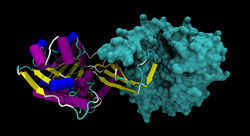Ketohexokinase
| Ketohexokinase | ||
|---|---|---|

|
||
| Ribbon / surface model of the CHD dimer with inhibitor as rods, according to PDB 3NBW | ||
| Properties of human protein | ||
| Mass / length primary structure | 298 amino acids | |
| Secondary to quaternary structure | A + A, A + C, C + C | |
| Isoforms | A, C | |
| Identifier | ||
| Gene name | CHD | |
| External IDs | ||
| Enzyme classification | ||
| EC, category | 2.7.1.3 , kinase | |
| Response type | Phosphorylation | |
| Substrate | ATP + β-D-fructose | |
| Products | ADP + D-fructose-1-phosphate | |
| Occurrence | ||
| Homology family | Ketohexokinase | |
| Parent taxon | Euteleostomi | |
Ketohexokinase (KHK) (also: hepatic fructokinase or simply fructokinase ) is the name of the enzyme that phosphorylates fructose . This is the first step in the utilization of fructose by vertebrates . In humans, CHD is localized above average in the liver , kidneys , intestines , spleen and pancreas . Mutations in CHD - gene can be used for (rare) fructosuria result, the hereditary inability to digest fructose - it is excreted in this case in the urine.
There are two isoforms of CHD, called A and C, that result from alternative splicing . Isoform C is mainly localized in the liver. Active CHD is a dimer made up of one or both isoforms. Presumably there is only a deficiency in isoform C in fructosuria.
Catalyzed reaction
β- D- fructose is phosphorylated to fructose-1-phosphate . D - sorbose , D - agatose or 5 - dehydrofructose are possible as further substrates . The response is stimulated by the presence of potassium and slowed down by ADP .
Individual evidence
- ↑ a b UniProt P50053
- ↑ Asipu A, Hayward BE, O'Reilly J, Bonthron DT: Properties of normal and mutant recombinant human ketohexokinases and implications for the pathogenesis of essential fructosuria . In: Diabetes . 52, No. 9, September 2003, pp. 2426-32. PMID 12941785 .
- ↑ EC 2.7.1.3


